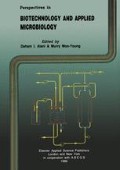Abstract
The most selenotolerant fungi, Aspergillus terreus, Aspergillus fumigatus Fresenius and Aspergillus speluneus, were isolated from Sinai Soil in Egypt. In addition to Penicillium chrysogenum, all were used to study selenium sorption.
The fungi failed mostly to sporulate and their morphological features were distorted completely. Their productivity of antimicrobial agents increased when grown on selenium containing media. However, the protein and carbohydrate content increased compared with selenium free media. Consequently, gave an impression that could be a mechanism of tolerance to selenium toxicity.
Access this chapter
Tax calculation will be finalised at checkout
Purchases are for personal use only
Preview
Unable to display preview. Download preview PDF.
References
Babich, H. and Stotsky, G. (1977) Sensitivity of certain bacteria including actinomycetes and fungi to cadmium and the influence of pH on sensitivity, App. Environ. Microbiol. 33: 681–695.
Copeland, R. (1970) Selenium: The unknown pollutants, Limnos 3: 7–9.
Fleming, R.W. and Alexander, M. (1982) Dimethylselenide and dimethyltelluride formation by a strain of Penicillium, Appl. Microbiol. 24: 424–429.
Gullino, M. and Fiusello, N. (1976) Azion del piombo sui funghi, Mic. Ital. 2: 27–32.
Lowry, O.H., Rosebrough, N.J., Furr, A.L. and Randall, R.J. (1951) Protein measurement with folin phenol reagents, J. Biol. Chem. 193: 265–275.
Ramadan, S.E. (1980) The Metabolic Pathway of Cystathionine and Its Selenium Analogues in Plants and Microorganisms, Ph.D. Thesis, University of London, London, U.K.
Ramadan, S.E., Haroun, B.M. and Razak, A.A. (1983) Morphological distortion of some fungi by the action of cadmium, selenium and tellurium, Proc. V Conf. Microbiol., Cairo Egypt, Vol. 1, 159–170.
Raper, K.B. and Fennell, D.I. (1977) The Aspergillus, Robert Ekrieger Publishing Company, Huntington, New York.
Razak, A.A. and Ramadan, S.E. (1984) Incorporation of selenium into certain protein amino acids in Penicillium chrysogenum E., Egypt. J. Microbiol. 10: 193–198.
Sedky, N.M. (1984) Microbiological and Biochemical Studies on Certain Metallotolerant Microorganisms, M.Sc., Fac. Sci. for Girls, Al-Azhar University, Cairo, Egypt.
Shrift, A. (1966) Methionine transport in Chlorella vulgaris, In Selenium, In: Mulh O.H. (ed.) Biomedicine, The Avi Publishing Company Inc., p. 241.
Umbriet, W.W., Burris, R.H., Stauffer, J.F., Cohen, P.P., Johnson, W.J., Lee Page, G.A., Patter, V.R. and Schneider, W.C. (1959) Manometric Techniques, A Manual Describing Methods Applicable to the Study of Tissue Metabolism, Burgess Publishing Company, p. 239.
Zeive, R. (1982) Selenium Volatilization from Soils and Plants and its Subsequent Reabsorption, Ph.D. Thesis, London University, London, U.K.
Author information
Authors and Affiliations
Editor information
Editors and Affiliations
Rights and permissions
Copyright information
© 1986 Elsevier Applied Science Publishers
About this chapter
Cite this chapter
Ragab, A.M., Ramadan, S.E., Razak, A.A., Ghonamy, E.A. (1986). Selenium Sorption by Some Selenotolerant Fungi. In: Alani, D.I., Moo-Young, M. (eds) Perspectives in Biotechnology and Applied Microbiology. Springer, Dordrecht. https://doi.org/10.1007/978-94-009-4321-6_26
Download citation
DOI: https://doi.org/10.1007/978-94-009-4321-6_26
Publisher Name: Springer, Dordrecht
Print ISBN: 978-94-010-8420-8
Online ISBN: 978-94-009-4321-6
eBook Packages: Springer Book Archive

